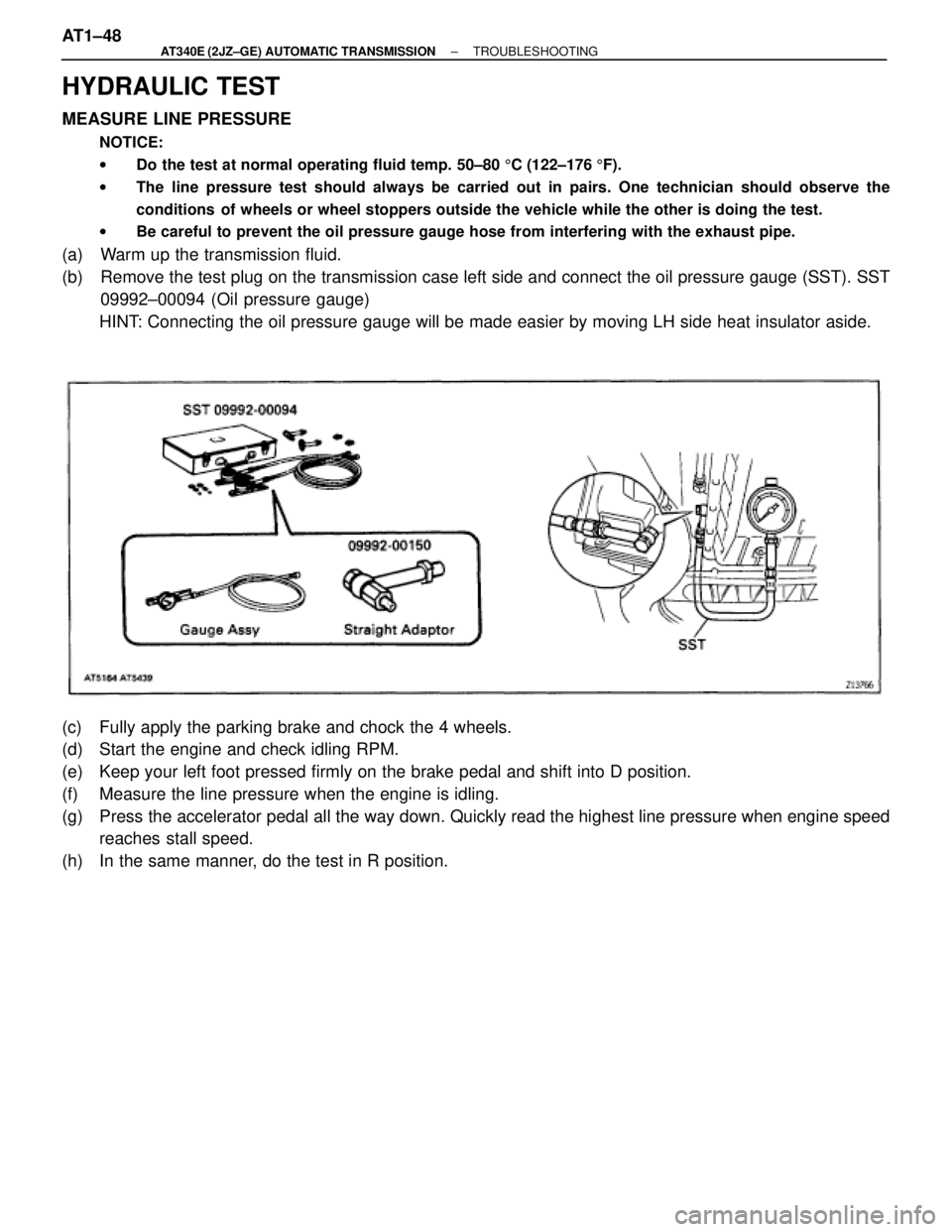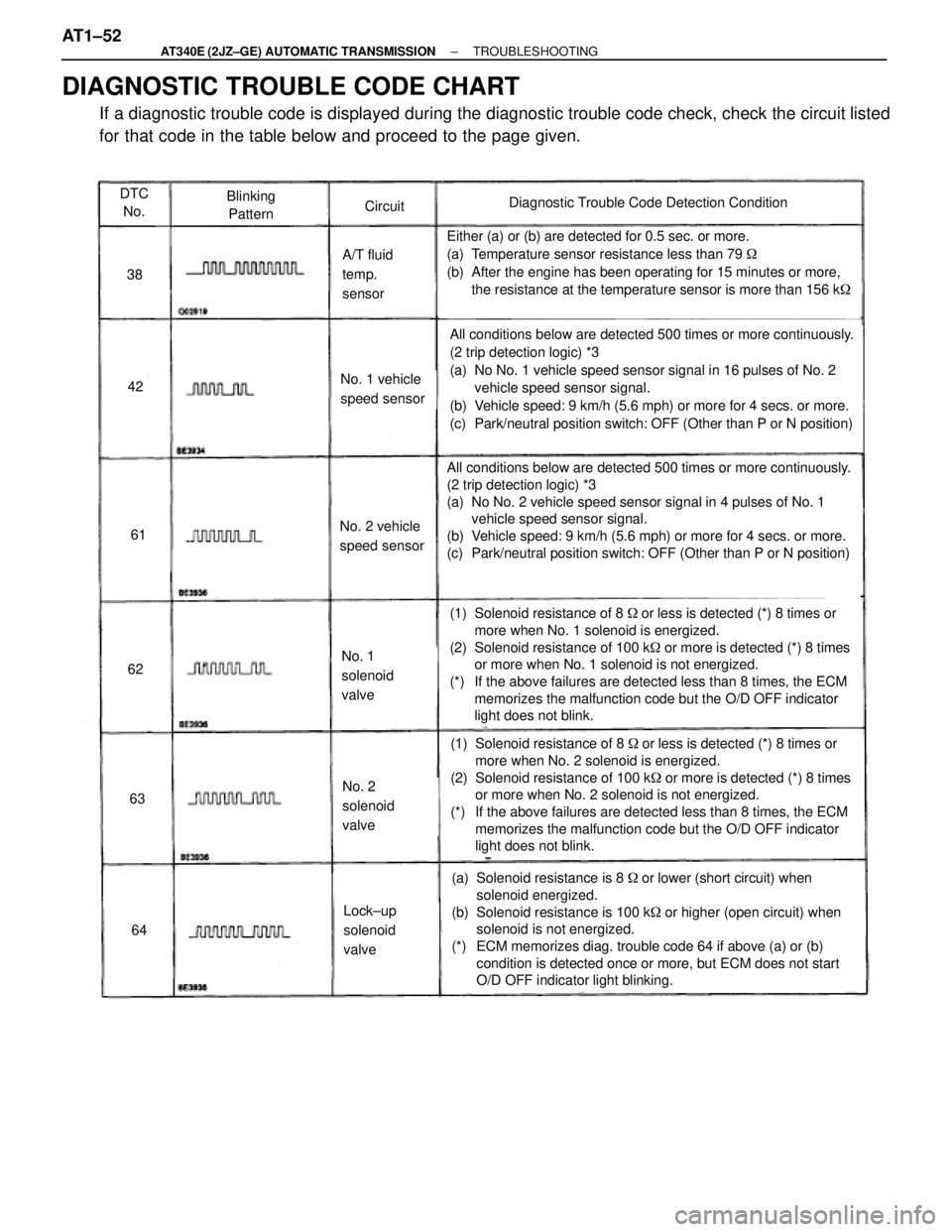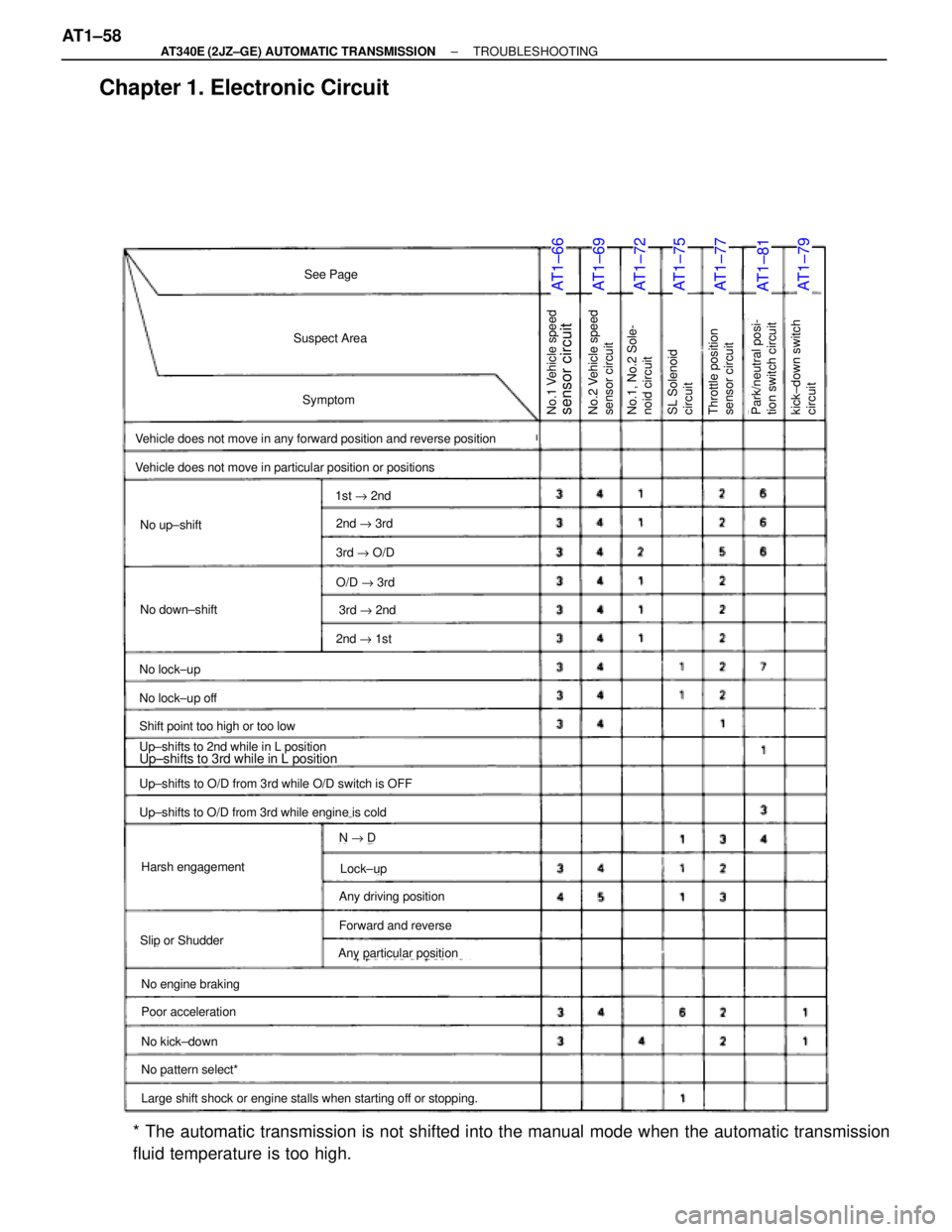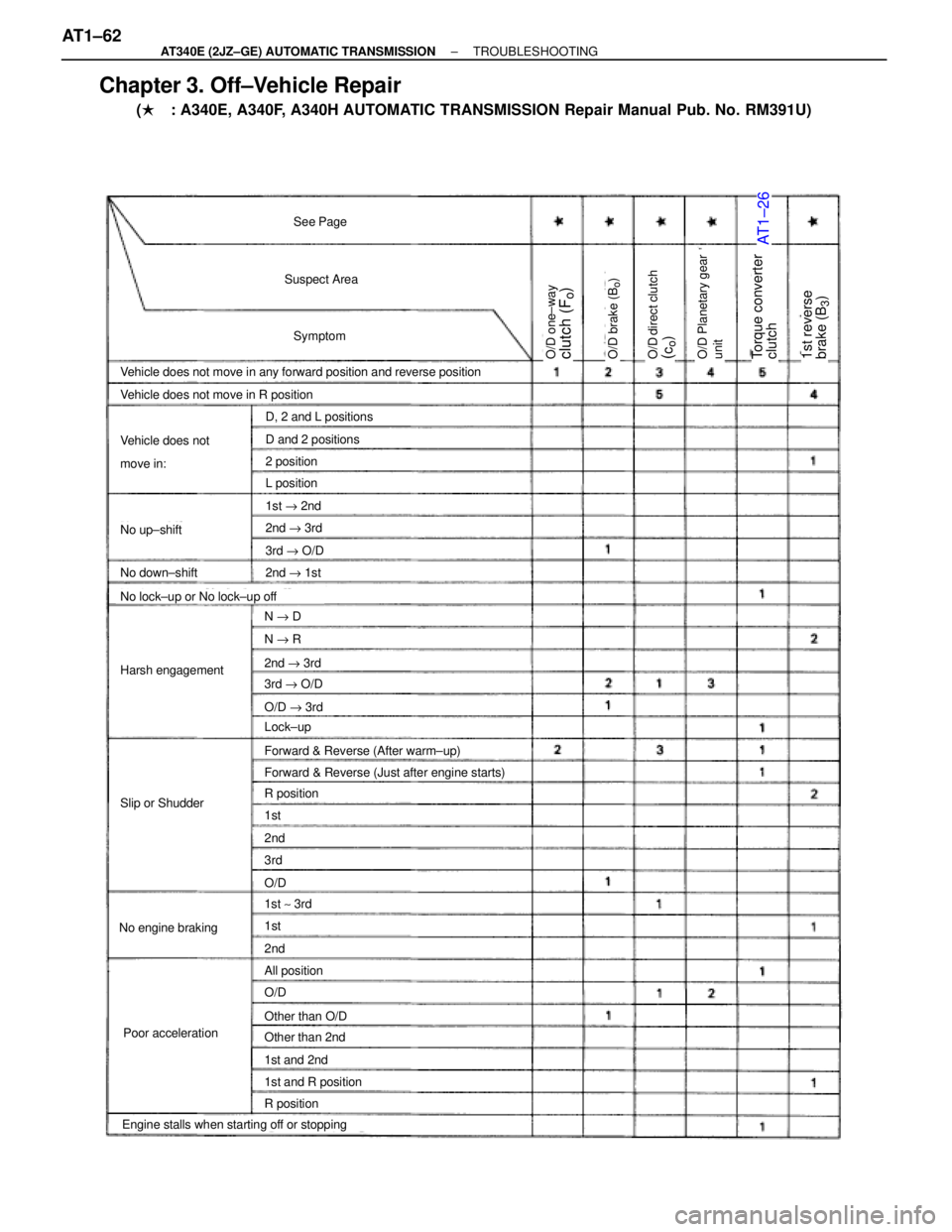Page 434 of 2543

HYDRAULIC TEST
MEASURE LINE PRESSURE
NOTICE:
wDo the test at normal operating fluid temp. 50±80 5C (122±176 5F).
wThe line pressure test should always be carried out in pairs. One technician should observe the
conditions of wheels or wheel stoppers outside the vehicle while the other is doing the test.
wBe careful to prevent the oil pressure gauge hose from interfering with the exhaust pipe.
(a) Warm up the transmission fluid.
(b) Remove the test plug on the transmission case left side and connect the oil pressure gauge (SST). SST
09992±00094 (Oil pressure gauge)
HINT: Connecting the oil pressure gauge will be made easier by moving LH side heat insulator aside.
(c) Fully apply the parking brake and chock the 4 wheels.
(d) Start the engine and check idling RPM.
(e) Keep your left foot pressed firmly on the brake pedal and shift into D position.
(f) Measure the line pressure when the engine is idling.
(g) Press the accelerator pedal all the way down. Quickly read the highest line pressure when engine speed
reaches stall speed.
(h) In the same manner, do the test in R position. AT1±48
± AT340E (2JZ±GE) AUTOMATIC TRANSMISSIONTROUBLESHOOTING
Page 438 of 2543

DTC
No.Blinking
PatternCircuitDiagnostic Trouble Code Detection Condition
38
42
Either (a) or (b) are detected for 0.5 sec. or more.
(a) Temperature sensor resistance less than 79 �
(b) After the engine has been operating for 15 minutes or more,
the resistance at the temperature sensor is more than 156 k�
All conditions below are detected 500 times or more continuously.
(2 trip detection logic) *3
(a) No No. 1 vehicle speed sensor signal in 16 pulses of No. 2
vehicle speed sensor signal.
(b) Vehicle speed: 9 km/h (5.6 mph) or more for 4 secs. or more.
(c) Park/neutral position switch: OFF (Other than P or N position)
A/T fluid
temp.
sensor
No. 1 vehicle
speed sensor
No. 2 vehicle
speed sensor
All conditions below are detected 500 times or more continuously.
(2 trip detection logic) *3
(a) No No. 2 vehicle speed sensor signal in 4 pulses of No. 1
vehicle speed sensor signal.
(b) Vehicle speed: 9 km/h (5.6 mph) or more for 4 secs. or more.
(c) Park/neutral position switch: OFF (Other than P or N position)
No. 1
solenoid
valve
(1) Solenoid resistance of 8 ��or less is detected (*) 8 times or
more when No. 1 solenoid is energized.
(2) Solenoid resistance of 100 k� or more is detected (*) 8 times
or more when No. 1 solenoid is not energized.
(*) If the above failures are detected less than 8 times, the ECM
memorizes the malfunction code but the O/D OFF indicator
light does not blink.
No. 2
solenoid
valve
(1) Solenoid resistance of 8 ��or less is detected (*) 8 times or
more when No. 2 solenoid is energized.
(2) Solenoid resistance of 100 k� or more is detected (*) 8 times
or more when No. 2 solenoid is not energized.
(*) If the above failures are detected less than 8 times, the ECM
memorizes the malfunction code but the O/D OFF indicator
light does not blink.
Lock±up
solenoid
valve
(a) Solenoid resistance is 8 ��or lower (short circuit) when
solenoid energized.
(b) Solenoid resistance is 100 k� or higher (open circuit) when
solenoid is not energized.
(*) ECM memorizes diag. trouble code 64 if above (a) or (b)
condition is detected once or more, but ECM does not start
O/D OFF indicator light blinking.
61
62
63
64
DIAGNOSTIC TROUBLE CODE CHART
If a diagnostic trouble code is displayed during the diagnostic trouble code check, check the circuit listed
for that code in the table below and proceed to the page given. AT1±52
± AT340E (2JZ±GE) AUTOMATIC TRANSMISSIONTROUBLESHOOTING
Page 444 of 2543

Chapter 1. Electronic Circuit
AT1±66AT1±69AT1±72AT1±75AT1±77AT1±81AT1±79
No.1 Vehicle speedsensor circuitNo.2 Vehicle speed
sensor circuitNo.1, No.2 Sole-
noid circuitkick±down switch
circuitThrottle position
sensor circuitSL Solenoid
circuitPark/neutral posi-
tion switch circuit
See Page
Suspect Area
Symptom
Vehicle does not move in any forward position and reverse position
Vehicle does not move in particular position or positions
No up±shift
No down±shift
No lock±up
No lock±up off
Shift point too high or too low
Up±shifts to 2nd while in L positionUp±shifts to 3rd while in L position
Up±shifts to O/D from 3rd while O/D switch is OFF
Up±shifts to O/D from 3rd while engine is cold
Harsh engagement
Slip or Shudder
Poor acceleration
No kick±down
No engine braking
No pattern select*
Large shift shock or engine stalls when starting off or stopping.
Any particular position
Forward and reverse
Any driving position
Lock±up
N " D
1st " 2nd
2nd " 3rd
3rd " O/D
O/D " 3rd
3rd " 2nd
2nd " 1st
* The automatic transmission is not shifted into the manual mode when the automatic transmission
fluid temperature is too high. AT1±58
± AT340E (2JZ±GE) AUTOMATIC TRANSMISSIONTROUBLESHOOTING
Page 445 of 2543
AT1±83AT1±85AT1±88AT1±91AT1±64EG±312AT1±56AT1±60AT1±62
Stop light switch
circuitPattern select switch
circuitO/D switch O/D OFF
indicator light circuitECMA/T fluid temp.
sensor circuitO/D cancel signal
circuitEngine coolant
temp. switch circuitOFF±Vehicle repairmatrix chartOn±Vehicle repairmatrix chart
± AT340E (2JZ±GE) AUTOMATIC TRANSMISSIONTROUBLESHOOTINGAT1±59
Page 446 of 2543
Chapter 2. On±Vehicle Repair
(� : A340E, A340F, A340H AUTOMATIC TRANSMISSION Repair Manual Pub. No. RM391U)
AT1±43AT1±43
See Page
Suspect Area
Symptom
Vehicle does not move in any forward position and reverse position
Vehicle does not move in particular position or positions
No up±shift
No down±shift
No lock±up or No lock±up off
Vehicle does not move in particular position or positions
(except R position)
Harsh engagement
Slip or Shudder
No kick±down
No engine braking
N " D
1st " 2nd
2nd " 3rd
3rd " O/D
O/D " 3rd
3rd " 2nd
2nd " 1st
N " D
N " R
1st " 2nd (2 position)
2nd " 3rd " O/D
2nd " 3rd
3rd " O/D
O/D " 3rd
Lock±up
1st " 2nd (D position)
1st " 2nd "
3rd " O/D
2nd
1st
Particular position
Forward and Reverse
Throttle cable1±2 shift valve2±3 shift valveThrottle valveManual valveParking lock pawlOil strainerTransmission
control rod
AT1±60± AT340E (2JZ±GE) AUTOMATIC TRANSMISSIONTROUBLESHOOTING
Page 448 of 2543

Chapter 3. Off±Vehicle Repair
(��: A340E, A340F, A340H AUTOMATIC TRANSMISSION Repair Manual Pub. No. RM391U)
AT1±26
See Page
Suspect Area
Symptom
Vehicle does not move in any forward position and reverse position
Vehicle does not move in R position
No up±shift
No down±shift
Harsh engagement
Slip or Shudder
1st " 2nd
2nd " 3rd
3rd " O/D
O/D " 3rd
L position
2nd " 1st
D, 2 and L positions
D and 2 positions
2 position
Vehicle does not
move in:
No lock±up or No lock±up off
N " D
N " R
2nd " 3rd
3rd " O/D
Lock±up
Forward & Reverse (After warm±up)
Forward & Reverse (Just after engine starts)
R position
No engine braking
2nd
1st
3rd
2nd
1st
1st ~ 3rd
O/D
O/D
All position
Other than O/D
1st and 2nd
1st and R position
R position
Other than 2ndPoor acceleration
Engine stalls when starting off or stopping
O/D one±wayclutch (F
o)
O/D brake (B
o)
Torque converter
clutchO/D Planetary gear
unitO/D
direct clutch
(co)
1st reverse
brake (B
3)
AT1±62± AT340E (2JZ±GE) AUTOMATIC TRANSMISSIONTROUBLESHOOTING
Page 450 of 2543
CIRCUIT INSPECTION
DTC 38 A T Fluid Temperature Sensor Circuit
CIRCUIT DESCRIPTION
The fluid temp. sensor converts fluid temp. into resistance values which is input into the ECM.
������ ������DTC No.������������������� �������������������Diagnostic Trouble Code Detection Condition������������� �������������Trouble Area
������ �
����� �
����� �
����� �
����� ������
38
������������������� �
������������������ �
������������������ �
������������������ �
������������������ �������������������
Either (a) or (b) are detected for 0.5 sec. or more
(a) Temp. sensor resistance less than 79 �
(b) After the engine has been operating for 15 minutes
or more, the resistance at the temp. sensor is more than
156 k�������������� �
������������ �
������������ �
������������ �
������������ �������������
�Harness or connector between A/T
fluid temp. sensor and ECM
� A/T fluid temp. sensor
� ECM
± AT340E (2JZ±GE) AUTOMATIC TRANSMISSIONTROUBLESHOOTINGAT1±64
Page 469 of 2543
See
Stop Light Switch Circuit
CIRCUIT DESCRIPTION
The purpose of this circuit is to prevent the engine from stalling, while driving in lock±up condition, when brakes
are suddenly applied.
When the brake pedal is operated, this switch sends a signal to ECM. Then the ECM cancels operation of the
lock±up clutch while braking is in progress.
WIRING DIAGRAM
INSPECTION PROCEDURE
Check operation of stop light.
Check and repair stop light circuit.
Check if the stop lights go on and off normally when the brake pedal is depressed and
released.
± AT340E (2JZ±GE) AUTOMATIC TRANSMISSIONTROUBLESHOOTINGAT1±83